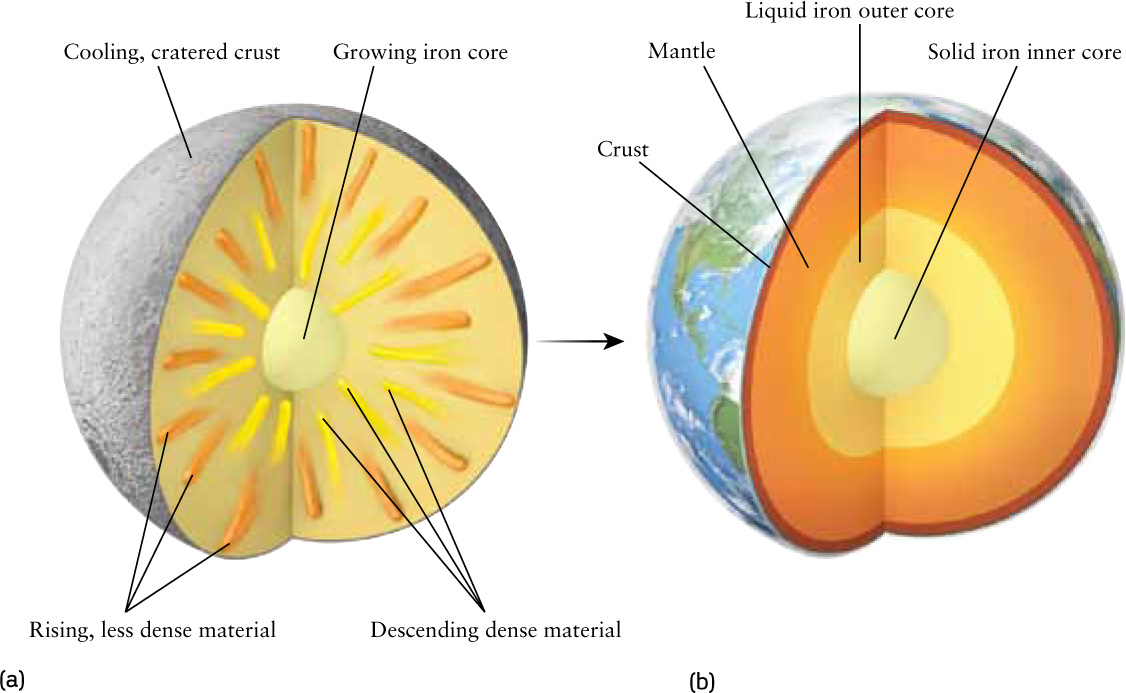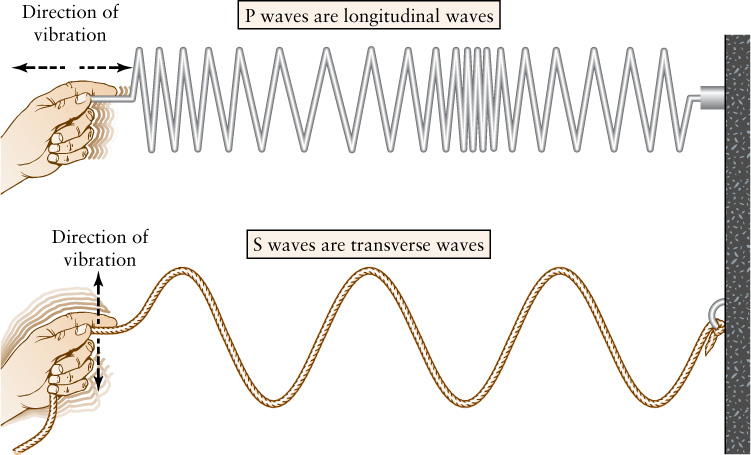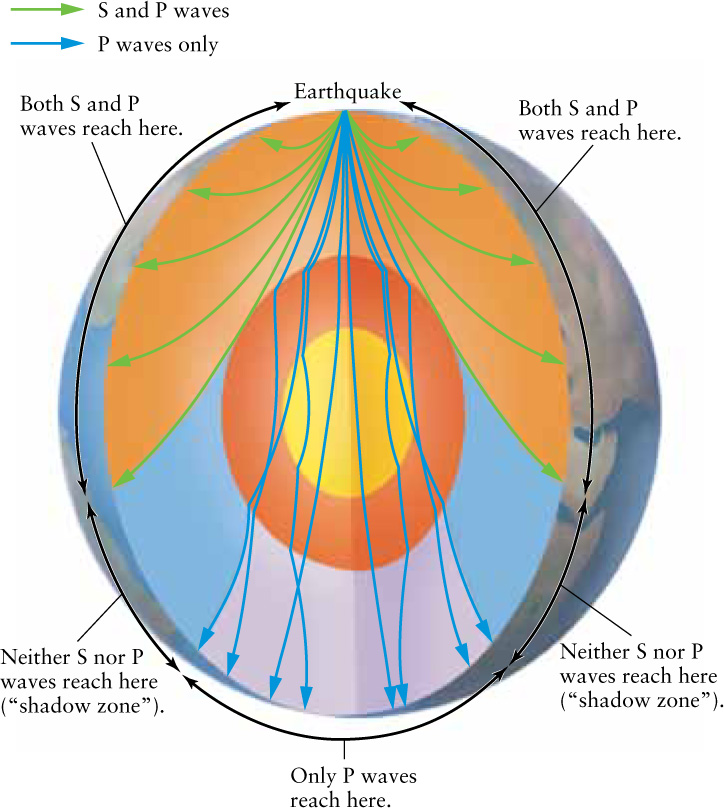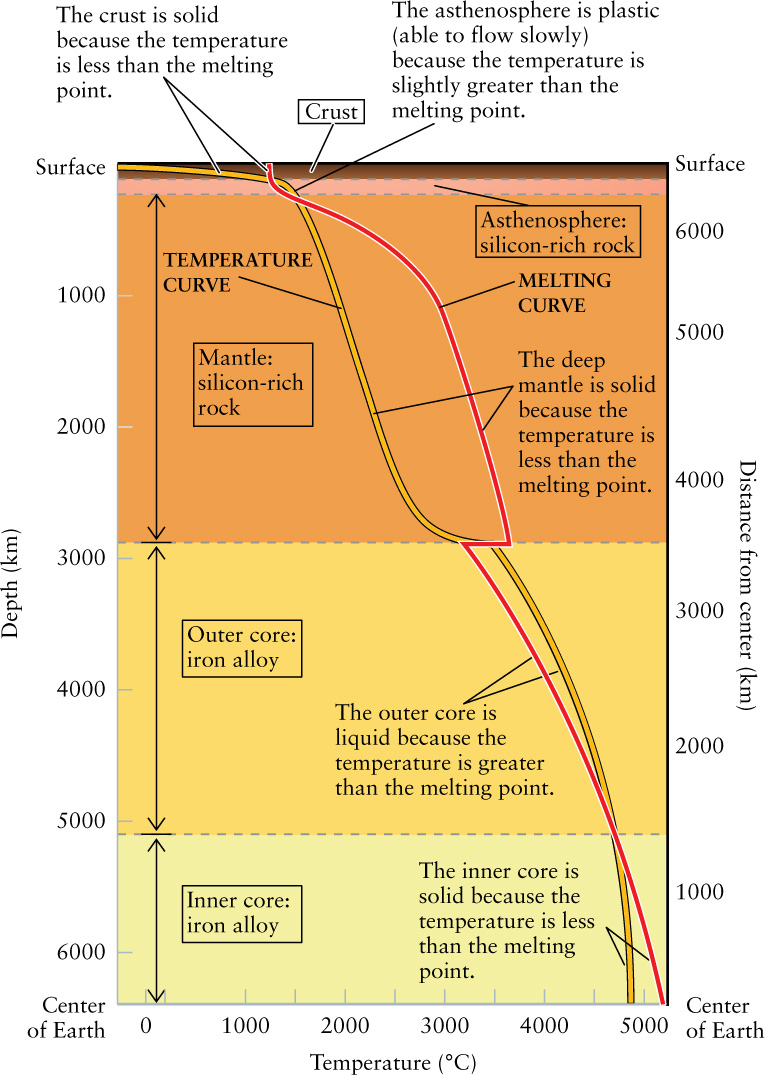9-2 Studies of earthquakes reveal Earth’s layered interior structure
Like an exotic dessert, our planet’s interior has layers of both solid and liquid material
 The kinds of rocks found on and near Earth’s surface provide an important clue about our planet’s interior. The densities of typical surface rocks, including the rocky seafloor, are around 3000 kg/m3, but the average density of Earth as a whole (that is, its mass divided by its volume) is 5515 kg/m3. The interior of Earth must therefore be composed of substances much denser than those found near the surface. But what is this substance? Why is Earth’s interior more dense than its crust? And is Earth’s interior solid like rock or molten like lava?
The kinds of rocks found on and near Earth’s surface provide an important clue about our planet’s interior. The densities of typical surface rocks, including the rocky seafloor, are around 3000 kg/m3, but the average density of Earth as a whole (that is, its mass divided by its volume) is 5515 kg/m3. The interior of Earth must therefore be composed of substances much denser than those found near the surface. But what is this substance? Why is Earth’s interior more dense than its crust? And is Earth’s interior solid like rock or molten like lava?
230
An Iron-Rich Planet
Iron (chemical symbol Fe) is a good candidate for the substance that makes up most of Earth’s interior for two reasons. First, iron atoms are quite massive (a typical iron atom has 56 times the mass of a hydrogen atom), and second, iron is relatively abundant. (Figure 8-4 shows that it is the seventh most abundant element in our part of the Milky Way Galaxy.) Other elements such as lead and uranium have more massive atoms, but these elements are quite rare. Hence, the solar nebula could not have had enough of these massive atoms to create Earth’s dense interior. Furthermore, iron is common in meteoroids that strike Earth, which suggests that it was abundant in the planetesimals from which Earth formed.
Earth was almost certainly molten throughout its volume soon after its formation, about 4.54 × 109 years ago. Energy released by the violent impacts of numerous meteoroids and asteroids and by the decay of radioactive isotopes likely melted the solid material collected from the earlier planetesimals. Gravity caused abundant, dense iron to sink toward Earth’s center, forcing less dense material to the surface. Figure 9-7a shows this process of chemical differentiation. (We discussed chemical differentiation in Section 8-5.) The result was a planet with the layered structure shown in Figure 9-7b—a central core composed of almost pure iron, surrounded by a mantle of dense, iron-rich minerals. The mantle, in turn, is surrounded by a thin crust of relatively light silicon-rich minerals. We live on the surface of this crust.

Seismic Waves as Earth Probes
How do we know that this layered structure is correct? The challenge in testing this model is that Earth’s interior is as inaccessible as the most distant galaxies in space. The deepest wells go down only a few kilometers, barely penetrating the surface of our planet. Despite these difficulties, geologists have learned basic properties of Earth’s interior by studying earthquakes and the seismic waves that they produce.
Over the centuries, forces build up in Earth’s crust. Occasionally, these forces are relieved with a sudden motion called an earthquake. Most earthquakes occur within 20 km of Earth’s surface. The point on Earth’s surface directly over an earthquake’s location is called the epicenter.

 Seismic Waves Earthquakes produce two kinds of waves that travel through the body of our planet. One kind, called P waves, are longitudinal waves. They are analogous to those produced by pushing a spring in and out. The other kind, S waves, are transverse waves analogous to the waves produced by shaking a rope up and down.
Seismic Waves Earthquakes produce two kinds of waves that travel through the body of our planet. One kind, called P waves, are longitudinal waves. They are analogous to those produced by pushing a spring in and out. The other kind, S waves, are transverse waves analogous to the waves produced by shaking a rope up and down.
Earthquakes produce three different kinds of seismic waves, which travel around or through Earth in different ways and at different speeds. Geologists use sensitive instruments called seismometer to detect and record these vibratory motions. The first type of wave, which is analogous to ocean waves, causes the rolling motion that people feel around an epicenter. These waves are called surface waves because they travel only over Earth’s surface. The two other kinds of waves, called P waves (for “primary”) and S waves (for “secondary”), travel through the interior of Earth. P waves are called longitudinal waves because their oscillations are parallel to the direction of wave motion, like a spring that is alternately pushed and pulled. In contrast, S waves are called transverse waves because their vibrations are perpendicular to the direction in which the waves move. S waves are analogous to waves produced by a person shaking a rope up and down (Figure 9-8).
231
What makes seismic waves useful for learning about Earth’s interior is that they do not travel in straight lines. Instead, the paths that they follow through the body of Earth are bent because of the varying density and composition of Earth’s interior. We saw in Section 6-1 that light waves behave in a very similar way. Just as light waves bend, or refract, when they pass from air into glass or vice versa (see Figure 6-2), seismic waves refract as they pass through different parts of Earth’s interior. By studying how the paths of these waves bend, geologists can map out the general interior structure of Earth.
One key observation about seismic waves and how they bend has to do with the differences between S and P waves. When an earthquake occurs, seismometers relatively close to the epicenter record both S and P waves, but seismometers on the opposite side of Earth record only P waves. The absence of S waves was first explained in 1906 by British geologist Richard Dixon Oldham, who noted that transverse vibrations such as S waves cannot travel far through liquids. Oldham therefore concluded that our planet has a molten core. Furthermore, there is a region in which neither S waves nor P waves from a distant earthquake can be detected (Figure 9-9). This “shadow zone” results from the specific way in which P waves are deflected at the boundary between the solid mantle and the liquid iron outer core (the molten core). By measuring the size of the shadow zone, geologists have concluded that the radius of the molten core is about 3500 km (2200 mi), about 55% of our planet’s overall radius but about double the radius of the Moon (1738 km = 1080 mi).

As the quality and sensitivity of seismometers improved, geologists discovered faint traces of P waves in an earthquake’s shadow zone. In 1936, the Danish seismologist Inge Lehmann explained that some of the P waves passing through Earth are deflected into the shadow zone by a small, solid inner core at the center of our planet. The radius of this solid iron inner core is about 1300 km (800 mi).
Earth’s Major Layers
 The seismic evidence reveals that our planet has a curious internal structure—a liquid outer core of iron sandwiched between a solid inner iron core and a solid mantle.Table 9-3 summarizes this structure. To understand this arrangement, we must look at how temperature and pressure inside Earth affect the melting point of rock.
The seismic evidence reveals that our planet has a curious internal structure—a liquid outer core of iron sandwiched between a solid inner iron core and a solid mantle.Table 9-3 summarizes this structure. To understand this arrangement, we must look at how temperature and pressure inside Earth affect the melting point of rock.
| Region | Depth Below Surface (km) | Distance From Center (km) | Average Density (kg/m3) |
|---|---|---|---|
| Crust (solid) | 0–5 (under oceans) 0–35 (under continents) |
6343–6378 | 3500 |
| Mantle (plastic, solid) | from bottom of crust to 2900 | 3500–6343 | 3500–5500 |
| Outer core (liquid) | 2900–5100 | 1300–3500 | 10,000–12,000 |
| Inner core (solid) | 5100–6400 | 0–1300 | 13,000 |
Both temperature and pressure increase with increasing depth below Earth’s surface. The temperature of Earth’s interior rises steadily from about 14°C on the surface to nearly 5000°C at our planet’s center (Figure 9-10).

Earth’s outermost layer, the crust, is only about 5 to 35 km thick. It is composed of rocks for which the melting point, or temperature at which the rock changes from solid to liquid, is far higher than the temperatures actually found in the crust. Thus, the crust is solid.
232
Earth’s mantle, which extends to a depth of about 2900 km (1800 mi), is largely composed of substances rich in iron and magnesium. On Earth’s surface, specimens of these substances have melting points slightly over 1000°C. However, the melting point of a substance depends on the pressure to which it is subjected—the higher the pressure, the higher the melting point. As Figure 9-10 shows, the actual temperatures throughout most of the mantle are less than the melting point of all the substances of which the mantle is made. Hence, the mantle is primarily solid. However, the upper levels of the mantle—called the asthenosphere (from the Greek asthenia, meaning “weakness”)—are able to flow slowly and are therefore referred to as being plastic.
CAUTION!
It may seem strange to think of a plastic material as one that is able to flow. Normally we think of plastic objects as being hard and solid, like the rigid plastic exterior of a computer or cell phone. But to make these objects, the plastic material is heated so that it can flow into a mold, then cooled so that it solidifies. Strictly speaking, the material only has a “plastic” property when it is able to flow. Maple syrup and tree sap are two other substances that flow at warm temperatures but become more solid when cooled. Furthermore, as with the asthenosphere, a material might seem solid to us if we could touch it, but actually flows when enormous forces act on it over millions of years.
At the boundary between the mantle and the outer core, there is an abrupt change in chemical composition, from silicon-rich materials to a mixture of iron (about 80%) with some nickel. Because this iron-nickel mixture has a lower melting point than the silicon-rich material above it, the melting curve in Figure 9-10 changes abruptly as it crosses from the mantle down into the outer core. As a result, the outer core is liquid.
At depths greater than about 5100 km, the pressure is more than 1011 newtons per square meter. This is about the same pressure that 3000 mid-size cars would make if stacked and balanced on a quarter! Because the melting point of the iron-nickel mixture under this pressure is higher than the actual temperature (see Figure 9-10), Earth’s inner core is solid.
 Until the 1980s, geologists knew little more about the inner core than that it is solid and dense. Since then, evidence from seismic waves has accumulated that suggests the inner core is a single crystal of iron—that is, iron atoms arranged in orderly rows, like carbon atoms are arranged within a diamond. If so, the inner core is the largest known crystalline object anywhere in the solar system. Furthermore, there are strong indications that the inner core is rotating at a slightly faster rate than the rest of Earth! These remarkable discoveries suggest that even more surprises may lurk deep within Earth’s interior.
Until the 1980s, geologists knew little more about the inner core than that it is solid and dense. Since then, evidence from seismic waves has accumulated that suggests the inner core is a single crystal of iron—that is, iron atoms arranged in orderly rows, like carbon atoms are arranged within a diamond. If so, the inner core is the largest known crystalline object anywhere in the solar system. Furthermore, there are strong indications that the inner core is rotating at a slightly faster rate than the rest of Earth! These remarkable discoveries suggest that even more surprises may lurk deep within Earth’s interior.
233
Heat naturally flows from where the temperature is high to where it is low. Figure 9-10 thus explains why heat flows from the center of Earth outward. We will see in the next section how this heat flow acts as the “engine” that powers our planet’s geologic activity.
CONCEPT CHECK 9-3
Hypothetically, what would have changed about Earth’s interior if S waves from earthquakes suddenly started being observed on the side of Earth opposite an earthquake?